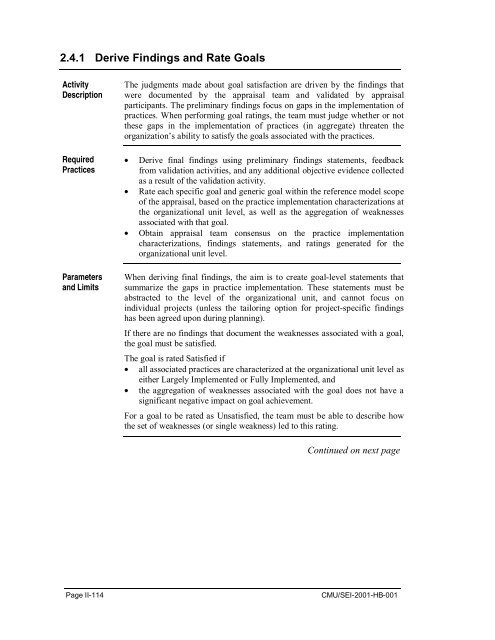Standard CMMI Appraisal Method for Process Improvement (SCAMPI)
Standard CMMI Appraisal Method for Process Improvement (SCAMPI)
Standard CMMI Appraisal Method for Process Improvement (SCAMPI)
Create successful ePaper yourself
Turn your PDF publications into a flip-book with our unique Google optimized e-Paper software.
2.4.1 Derive Findings and Rate Goals<br />
Activity<br />
Description<br />
Required<br />
Practices<br />
Parameters<br />
and Limits<br />
The judgments made about goal satisfaction are driven by the findings that<br />
were documented by the appraisal team and validated by appraisal<br />
participants. The preliminary findings focus on gaps in the implementation of<br />
practices. When per<strong>for</strong>ming goal ratings, the team must judge whether or not<br />
these gaps in the implementation of practices (in aggregate) threaten the<br />
organization’s ability to satisfy the goals associated with the practices.<br />
• Derive final findings using preliminary findings statements, feedback<br />
from validation activities, and any additional objective evidence collected<br />
as a result of the validation activity.<br />
• Rate each specific goal and generic goal within the reference model scope<br />
of the appraisal, based on the practice implementation characterizations at<br />
the organizational unit level, as well as the aggregation of weaknesses<br />
associated with that goal.<br />
• Obtain appraisal team consensus on the practice implementation<br />
characterizations, findings statements, and ratings generated <strong>for</strong> the<br />
organizational unit level.<br />
When deriving final findings, the aim is to create goal-level statements that<br />
summarize the gaps in practice implementation. These statements must be<br />
abstracted to the level of the organizational unit, and cannot focus on<br />
individual projects (unless the tailoring option <strong>for</strong> project-specific findings<br />
has been agreed upon during planning).<br />
If there are no findings that document the weaknesses associated with a goal,<br />
the goal must be satisfied.<br />
The goal is rated Satisfied if<br />
• all associated practices are characterized at the organizational unit level as<br />
either Largely Implemented or Fully Implemented, and<br />
• the aggregation of weaknesses associated with the goal does not have a<br />
significant negative impact on goal achievement.<br />
For a goal to be rated as Unsatisfied, the team must be able to describe how<br />
the set of weaknesses (or single weakness) led to this rating.<br />
Continued on next page<br />
Page II-114<br />
CMU/SEI-2001-HB-001
















